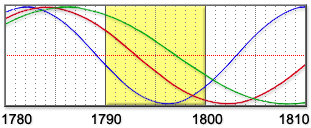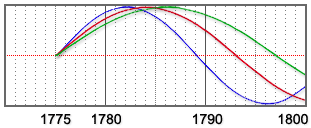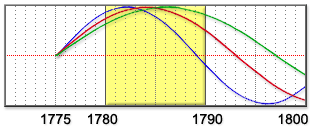
1790s: The Federalist Era lasted until the end of the century as Cycles crossed from their first Highs to their first Lows. In the High, Industry advanced with the invention of the cotton gin and
Standardized Mass Production. The
New York Stock Exchange began and aided business. The Treaty of Greenville was signed with twelve Indian tribes, but fighting continued as settlements pushed westward. All three Cycles ended their Highs from 1789 to 1797. The
Physical Cycle had already
Crossed Down in 1789. When the
Emotional Cycle Crossed Down in 1793
Thomas Jefferson Resigned as Washington's Secretary of State to head
the Opposing and Newly Formed Democratic-Republican Party. Federalist policy of centralized government yielded to the reforms of Democratic-Republicans when Jefferson defeated incumbent president John Adams in the elections of 1800. When the
Intellectual Cycle Crossed Down in 1798, we had the
XYZ Affair with France. A three-man commission went to France to negotiate a commerce treaty after France interfered with US shipping. French agents asked for tribute money but the US rejected the idea with resentment, repealed all treaties with France, and ordered the Navy to capture armed French vessels. In our first
3rd Qtrs. of Review and Reform, states ratified the first ten amendments to the Constitution as the
Bill of Rights came into law in 1791. We formed our
First Historical Association in Massachusetts in 1791.
Federal jurisdiction Over States was Limited in 1798. These reforms continued through the turn of the century, then alternative were sought as Cycles rose anew. The flow of rhythmic change and our internal clockwork of Cycles has been consistent since our very beginning.


 Kala. Chart horizontal
Kala. Chart horizontal

 for decade
for decade

 1775/76: The Birth of a Nation came with pains as America separated from its mother country, Great Britain. The Revolutionary War began on the evening of April 17-18, 1775 with the Battle of Lexington. By the end of 1775 America had its own Army, Navy & Marine Corps. It also had a newly formed Continental Congress to direct them, its own currency to finance them, and a new flag as its symbol. A new nation was alive, born in Spring, 1775. A new clockwork of Cycles began that have been in motion ever since. We published our renowned Declaration of Independence the following year on July 4th, 1776.
1775/76: The Birth of a Nation came with pains as America separated from its mother country, Great Britain. The Revolutionary War began on the evening of April 17-18, 1775 with the Battle of Lexington. By the end of 1775 America had its own Army, Navy & Marine Corps. It also had a newly formed Continental Congress to direct them, its own currency to finance them, and a new flag as its symbol. A new nation was alive, born in Spring, 1775. A new clockwork of Cycles began that have been in motion ever since. We published our renowned Declaration of Independence the following year on July 4th, 1776.
 1790s: The Federalist Era lasted until the end of the century as Cycles crossed from their first Highs to their first Lows. In the High, Industry advanced with the invention of the cotton gin and
1790s: The Federalist Era lasted until the end of the century as Cycles crossed from their first Highs to their first Lows. In the High, Industry advanced with the invention of the cotton gin and